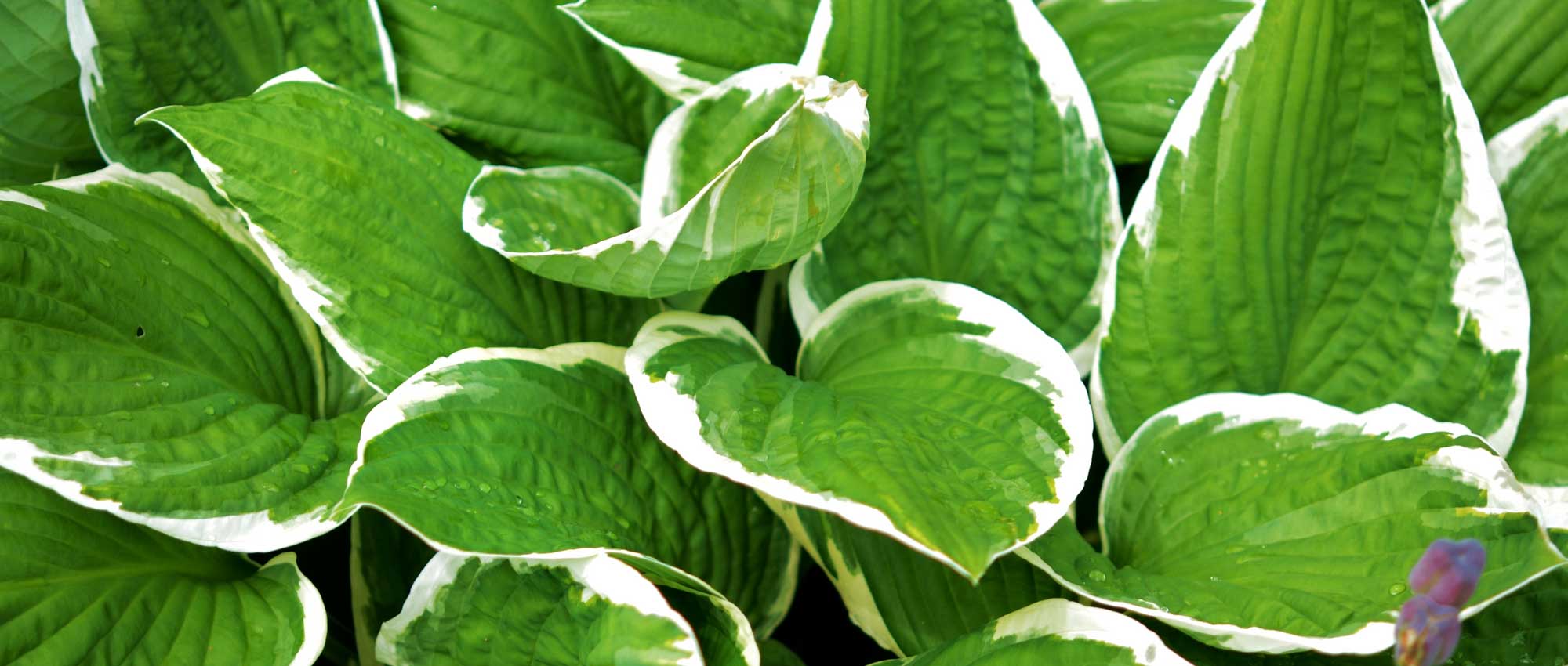
Hosta: planting, growing and care
Contents
Hostas in a nutshell
- Hostas are appreciated for their highly decorative foliage, in shades of green, blue, gold, or variegated
- They are easy, robust, and reliable plants, with a long lifespan!
- The hosta is an excellent ground cover for shade, forming clumps that spread over time!
- It offers delicate flowering, with bell-shaped flowers in lilac or white
- It is the perfect plant to dress up a cool shady corner
A word from our Expert
The hosta is a highly valued perennial herbaceous plant known for its large ovate or cordate leaves, which display stunning colours. It indeed boasts ample and generous foliage, lush, with hues that are quite varied: it can be green, blue as seen in hosta ‘Halcyon’, sometimes golden, often variegated with white or cream, like Hosta ‘Fire and Ice’… Hostas offer an enormous diversity in their colours and sizes… You will easily find a variety that you like! Beyond their foliage, they are also appreciated for their remarkable summer flowering, especially in certain species like Hosta plantaginea!
The hosta thrives in rather shady and cool situations, but can also be planted in non-burning sunlight, and adapts quite well to pot cultivation. Variegated varieties or those with golden foliage are ideal for bringing brightness to a woodland area! The hosta is a long-lived plant that endures in the garden with very little maintenance. It has the advantage of withstanding shade, heavy soils, and cold! It is particularly vulnerable to slugs, which devour the foliage, as well as summer drought!
The hosta spreads to form large clumps, making it an excellent ground cover for shade. Although it easily finds its place in woodland areas, it is also perfect for city gardens! It can be planted in pots to enhance a courtyard, balcony, or patio! As it is a rather trendy plant, it integrates very well into modern or graphic gardens.
Description and Botany
Botanical data
- Latin name Hosta sp.
- Family Asparagaceae
- Common name Hosta, Funkia
- Flowering between June and September, depending on the varieties
- Height between 20 cm and 1 m
- Exposure shade, partial shade, or non-burning sun
- Soil type cool, humus-bearing, deep
- Hardiness between -15 and -20 °C
Hostas are perennial plants native to East Asia, highly valued for their decorative foliage. There are at least 23 species, although some specialists count up to forty. They primarily grow in China, Japan, and Korea. They are often found in moist areas, along waterways, in woodlands, or in rocky mountain environments. They were imported from Japan in the 19th century, notably by the physician and botanist Philipp Franz von Siebold, who named Hosta sieboldiana after himself. Hostas have since been extensively hybridised, and today there are over 3,000 horticultural varieties! As they originate from temperate regions, hostas are quite hardy plants.
They belong to the botanical family Asparagaceae (nearly 3,000 species), which includes agaves, chlorophytum, hyacinths, muscaris, squills, lilies of the valley, and ophiopogons. They were previously classified among the Liliaceae, the family of the lily… And it is true that hosta flowers somewhat resemble those of lilies.
Hostas were named in 1812 by Leopold Trattinnick (Austrian botanist), in honour of the Croatian botanist Nicolaus Thomas Host. A few years later (1817), they were called Funkia by the German botanist and physician Kurt Sprengel in tribute to the plant collector Heinrich Christian Funk. To comply with botanical nomenclature rules, the oldest name was retained. However, hostas continue to be sometimes referred to as funkia, although this name is much less common. In English, they are called “Plantain lilies” because their leaves have parallel veins, similar to plantain. In Japan, they are known as “giboshi”.
The hosta forms a dense clump that expands over time, making it a very good ground cover. It spreads through rhizomes or stolons, but is far from being an invasive plant! Hostas are perennial and easy plants that live long without requiring much maintenance.
Their size can vary greatly from one species to another: there are dwarf varieties, and others, giant ones! The smallest hostas measure around 20 cm tall, while the largest can exceed 1 m in height (the largest variety seems to be ‘Empress Wu’, reaching up to 1.30 m!). However, most varieties measure between 30 and 60 cm in height. The clumps are spreading, thus wider than tall, often reaching 60 cm to 1 m in width.
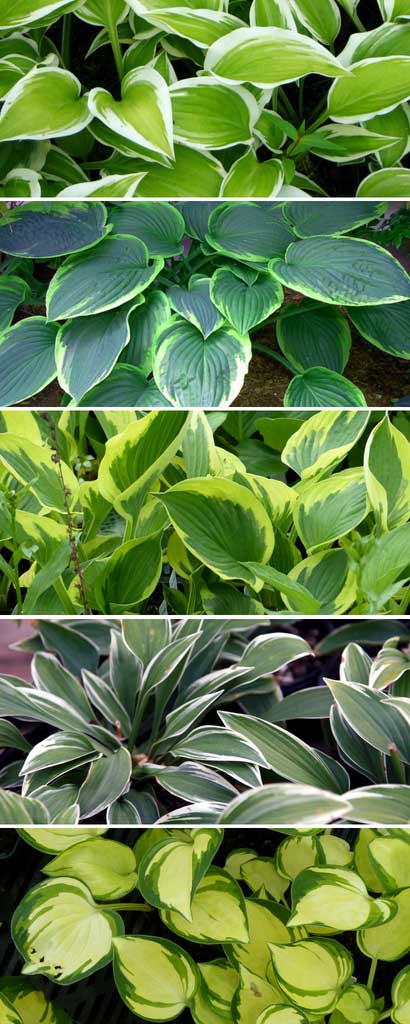
Hostas offer a beautiful diversity of foliage! From left to right: Hosta ‘Emily Dickinson’, Hosta tardiana ‘El Niño’, Hosta fortunei ‘Twilight’, Hosta ‘Allan P. McConnell’ (photo David J. Stang) and Hosta ‘Warwick Delight’
In spring, the leaves are initially rolled up. They then unfold, revealing elegant shapes and colours. In autumn, when the cold arrives, they take on a golden hue, then dry and disappear… only to reappear the following spring, late (in April – May). So don’t worry if the hosta seems dead if you don’t see it at the beginning of spring… You just need to wait a bit!
The leaves are broad, either ovate or cordate (heart-shaped). They often measure between 15 and 30 cm in length and are generally pointed at their tips. They are very rounded in hosta ‘Blue Mouse Ears’, resembling mouse ears… while in hosta ‘Stiletto’, they are fine and elongated! There are some very surprising varieties, such as ‘Curly Fries’, with linear and undulating leaves! It doesn’t really resemble a hosta anymore. The veins of hosta leaves are well visible and quite decorative! They sometimes give the leaf a plicate or even wrinkled appearance! The leaves are fleshy, quite thick, and flexible at the same time. They are very appealing to slugs! Some varieties have tough foliage, making them less appetising to these pests.
Hosta leaves have parallel veins, similar to those of plantain. This explains why their name in English is Plantain lilies: “plantain lily”. This same reference is found in the Latin name of Hosta plantaginea.
Hostas impress with the varied shades of their foliage. It can be light or dark green, golden yellow, or blue, more or less grey. It is often variegated with cream white, either in the centre of the leaf or conversely, on the outside. The variations in shades are impressive! Sometimes, the leaves are simply edged with a fine white border around the lamina. They can also be shaded, offering two similar tones, for example, blue-green and bright green. In hosta ‘June’, the colours and their intensity vary depending on the light, and thus the location you choose. Blue-leaved varieties have a waxy coating on them, giving them their characteristic colour. The sun causes them to lose this coating, which is why it’s better to place them in the shade… otherwise, they might turn green.
The visual effect is really different between the cool shades of blue hostas, the warm tones of golden-leaved varieties, or the very fresh appearance brought by the white variegated varieties! When the leaves are yellow, like ‘Fire Island’, the hosta brings a lot of brightness to a woodland.
The petiole of hostas is sometimes coloured: it is red in ‘Fire Island’, providing a beautiful contrast with the lamina!
Although they are mainly appreciated for their foliage, the flowering of hostas is no less attractive. It occurs in summer: between June and September, depending on the varieties, and can last up to two months.
Hostas then produce clusters of bell-shaped or trumpet-shaped flowers, borne above the foliage. The flower stalks give the plant a bit more height. The flowers located lower down open first, followed by those higher up on the stem. Their shape somewhat resembles lily flowers. They often measure between 2 and 4 cm long and are slightly inclined towards the ground. They are very elegant and take on a beautiful mauve-lilac or white hue. The petals are sometimes beautifully striped with violet-lilac!
The flowers are hermaphroditic, bearing both male (stamens) and female (pistil) organs. They consist of six petals, fused into a long narrow tube. Inside the corolla, there are six long stamens and a style. A bract is placed at the base of each flower, on the stem.

The flowering of Hosta ‘Dream Queen’, an inflorescence of hosta, and the flowers of Hosta longipes
Hosta plantaginea is particularly interesting for its flowering! Surprisingly, its flowers open in the evening and close in the morning. They are large (between 5 and 10 cm long), elegant, and fragrant! There is a variety with double flowers: Hosta plantaginea ‘Aphrodite’.
Hosta plantaginea, along with a few varieties like ‘Fragrant Bouquet’, are renowned for their fragrance. However, in most hostas, the flowers are not really aromatic.
Hostas have rhizomes, which allow them to spread. This makes them quite easy to divide. The roots of hostas are white and fleshy, quite thick.
After flowering, hostas produce elongated capsules, initially green, which then dry and turn brown when mature, opening to release numerous black seeds.
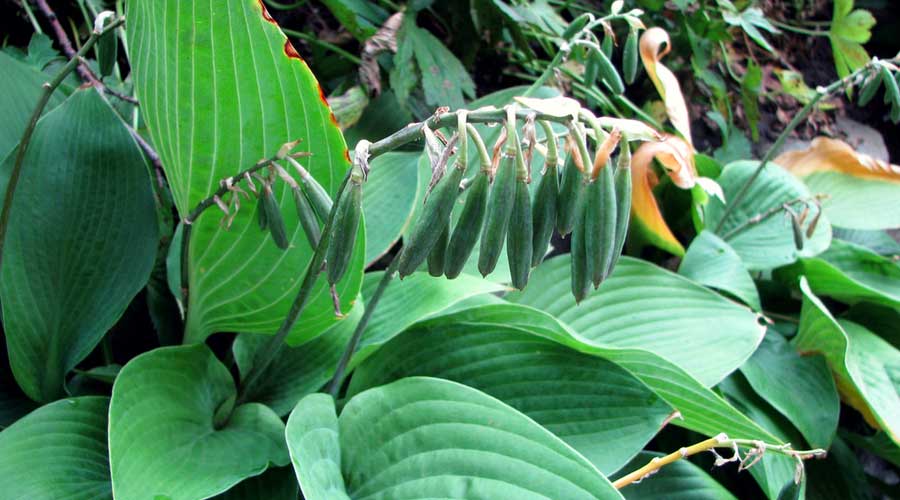
The fruits (capsules) of Hosta plantaginea, containing the seeds (photo Nova)
The main varieties of hosta
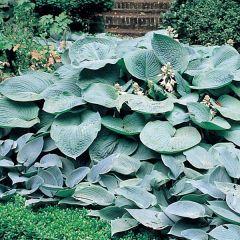
Hosta Big Daddy
- Flowering time August, September
- Height at maturity 80 cm
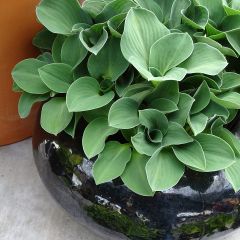
Hosta Blue Mouse Ears
- Flowering time August, September
- Height at maturity 15 cm
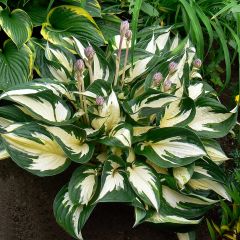
Hosta Fire and Ice
- Flowering time September, October
- Height at maturity 60 cm
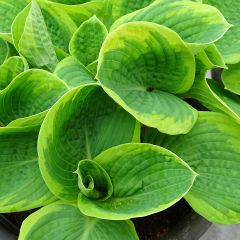
Hosta sieboldiana Frances Williams
- Flowering time August, September
- Height at maturity 60 cm
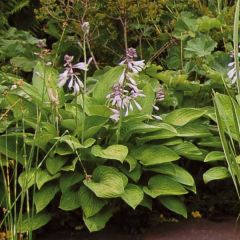
Hosta Sum and Substance
- Flowering time August, September
- Height at maturity 1 m
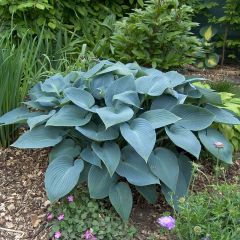
Hosta tardiana Halcyon - Blue Hosta
- Flowering time August, September
- Height at maturity 35 cm
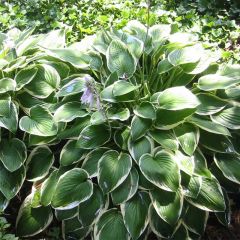
Hosta fortunei Francee
- Flowering time August, September
- Height at maturity 60 cm
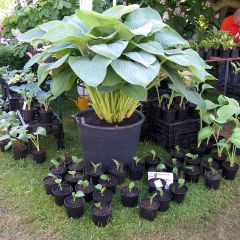
Hosta Empress Wu
- Flowering time July, August
- Height at maturity 1,35 m

Hosta plantaginea Aphrodite
- Flowering time September, October
- Height at maturity 50 cm

Hosta Stiletto
- Flowering time August, September
- Height at maturity 15 cm
⇒ Discover our tips for choosing your hostas well here.
Discover other Hostas - Plantain Lilies
View all →Available in 2 sizes
Available in 1 sizes
Available in 1 sizes
Available in 1 sizes
Available in 1 sizes
Available in 1 sizes
Available in 2 sizes
Available in 2 sizes
Available in 1 sizes
Available in 1 sizes
Where, when, and how to plant hostas
Where to plant?
Plant your hostas preferably in shade or partial shade! You can place them at the foot of trees or bushes. They will be less sensitive to drought if planted in the shade, as the soil will remain cool for longer. Avoid placing them in front of a white wall, which reflects heat and could scorch them.
However, contrary to popular belief, they can also be planted in the sun, avoiding scorching situations. In fact, if you want flowers, the hosta needs to enjoy at least a few hours of sun each day! The most suitable for bright exposures (non-scorching sun) are the light-leaved hostas, such as ‘August Moon’, and Hosta plantaginea. Similarly, Hosta ‘Guacamole’ enjoys being placed in the sun, while the varieties with blue leaves should rather be planted in the shade.
Unlike many plants, hostas tolerate heavy and clay soils quite well! They also prefer slightly acidic or neutral soils. Hostas enjoy soils that remain cool, even moist. They will thrive near a pond or water feature. Avoid overly dry areas of the garden! Preferably choose a location sheltered from cold, drying winds.
Hostas like deep soils. They are also quite greedy plants, thriving in soils rich in humus. A substrate like “woodland soil” is ideal. You can add well-decomposed compost to enrich your soil.
Hostas are perfect for occupying difficult-to-develop areas, such as those that are too shady or in heavy soil… They easily find their place in borders, as ground cover at the foot of trees or bushes, or in pots. You can plant them in a large pot or container to bring a touch of freshness to a terrace or patio, near horsetails, bamboo, ophiopogons, and ferns. Planting in pots will also help keep them safe from slugs!
The smallest varieties can even be integrated into a cool rockery.
Finally, avoid planting a young plant in isolation. It risks being devoured by slugs!
When to plant?
We recommend planting hostas in early spring, around April, but you can also plant them in autumn, around October. Avoid intervening during periods of intense heat.
How to plant hostas?
To successfully plant your hostas:
- Start by placing the root ball in a basin filled with water to rehydrate it.
- In the meantime, work the soil to loosen it and take the opportunity to add some compost or well-decomposed manure.
- Dig a hole two to three times the volume of the root ball.
- Place it in the planting hole, with the top of the root ball level with the soil.
- Fill in around it with soil, then lightly firm it down.
- Water generously.
It is advisable to continue watering in the weeks that follow, while the plant settles in and develops its root system.
We also recommend applying a mulch around the plant, made of dead leaves, ramial chipped wood (RCW), or linseed or hemp flakes, to a thickness of 5 to 10 centimetres.
If you are planting in a pot, there is no need to particularly work on drainage. Fill a pot with potting soil, possibly mixed with garden soil, and plant your hosta.
Discover our tips: Growing hostas in pots and The best varieties of hostas to grow in pots.
Caring for hostas
The maintenance of hostas is quite limited, as they are plants that persist in the garden and spread on their own. They are rarely affected by diseases and do not need to be protected from the cold in winter… They are particularly vulnerable to slugs and drought! Be vigilant to keep the soil cool, even moist. Pay extra attention if you have planted them in pots: the substrate dries out much faster than in open ground! Water regularly, preferably in the early morning, directing the stream at the base of the plant rather than on the foliage. We also recommend adding compost each year in spring to enrich the soil.
As the hosta disappears in autumn to reappear only late in spring, it is advisable to mark its location to remember that it is planted there! For example, place a label, a stake, or a small wooden support. This will help you avoid damaging it by accidentally hitting it with a spade while working the soil and planting other plants…
Hostas will appreciate if you add a layer of mulch around their base, with a thickness of 5 to 10 cm, choosing, for example, dead leaves or ramial chipped wood. This will help keep the soil cool!
You can cut the flower stems when they have faded, unless you wish to collect the seeds. Similarly, as the hosta is a deciduous plant, its foliage naturally dries out in autumn. We suggest cutting it back at that time. New leaves will develop in spring.
The main enemy of the hosta: slugs! Its generous and tender foliage inevitably attracts them, especially since it is often grown in shaded and cool areas, typically in woodlands… in other words, the habitat of slugs! Be cautious when hostas are still young, especially if they are planted alone. Slugs could cause real damage. However, if the clumps are large and ample, they may nibble a few leaves, but the plant will not be in real danger. You can use slug pellets, such as Ferramol, or ash. Also, be aware that there are varieties with thick, tough foliage that are more often ignored by slugs! For further reading on the subject: “Slugs, 7 ways to fight back, naturally”
Hostas grown in pots are sometimes attacked by vine weevils, a beetle whose larvae consume the roots of the plant, severely weakening it. To get rid of them, it is possible to use nematodes, Heterorhabditis bacteriophora, which parasitise the larvae.
→ To learn more, read our article: “The diseases and pests of Hosta.”
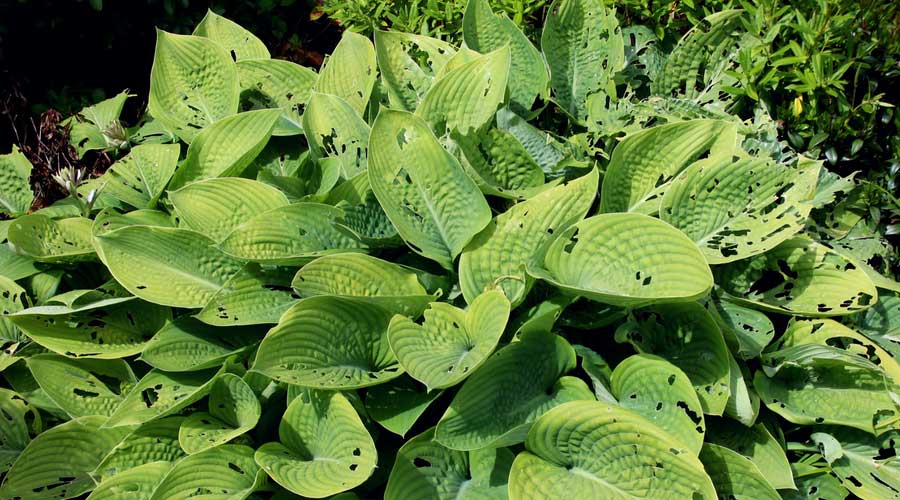
A hosta devoured by slugs!
Multiplying Hosta: Division
We recommend multiplying hostas by division. It is also possible to sow seeds in spring under a cold frame, but there is little chance that the seedlings produced will be identical to the original variety. The results are random!
Division of Clumps
Dividing clumps of hosta helps to regenerate the plants, rejuvenate them, and give them more vigour. You can do this approximately every five years, around September, or at the end of winter – beginning of spring.
In practice, to divide your hostas:
- Choose a well-developed, fairly large clump, several years old.
- If the plant still has leaves (division in early autumn), cut them off.
- Using a spade, go around the stump to unearth it, then lift it out of the ground.
- Cut the stump into several fragments using a spade, or simply by pulling apart the clump with your hands if it is not too large. Each fragment should retain at least two buds and enough roots.
- Prepare the soil and then replant immediately.
- Water generously.
Also, check out our video tips for dividing hostas and our tutorial How to divide hostas?
Combining Hostas in the Garden
Hostas are relatively easy perennials to combine, their foliage pairs well with a wide variety of plants! They are perfect for a woodland garden. For a wild and very natural effect, plant them with ferns, tricyrtis, and Solomon’s seals. You can also install naturalising bulbs (Allium ursinum, Camassia, Ornithogalum…). Enjoy the delicate flowering of Geranium nodosum or that of Montia sibirica! You can also combine them with brunneras, which also have large, decorative leaves. In partial shade, add colour with the flowering of foxgloves (Digitalis purpurea), bleeding hearts (Dicentra spectabilis), and Japanese anemones.
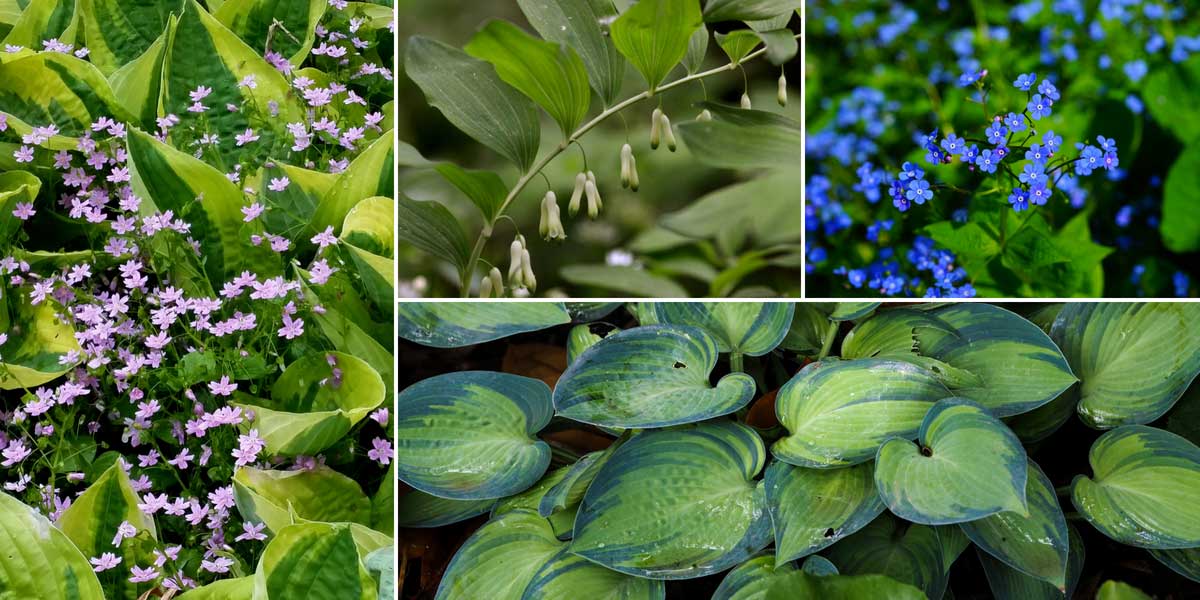
An idea for a woodland garden combination: Hosta ‘Twilight’ and Montia sibirica / Polygonatum multiflorum (photo Radio Tonreg) / Brunnera macrophylla / Hosta ‘June’
As it enjoys coolness, feel free to plant hostas near a pond or water feature, for example with ferns, Iris pseudacorus, and Asian primroses, such as Primula japonica.
You can achieve a stunning visual effect by combining hostas with variegated foliage and white flowers (Astilbes, Tulips, Roses…)! It is easy to create contrasts this way. Don’t hesitate to pair hostas with golden foliage, particularly that of Hakonechloa macra ‘Aureola’ or ‘All Gold’, but also Lysimachia nummularia ’Aurea’… Similarly, you can combine variegated hostas with other variegated-leaved plants! For example, enjoy Cornus alternifolia ‘Argentea’.
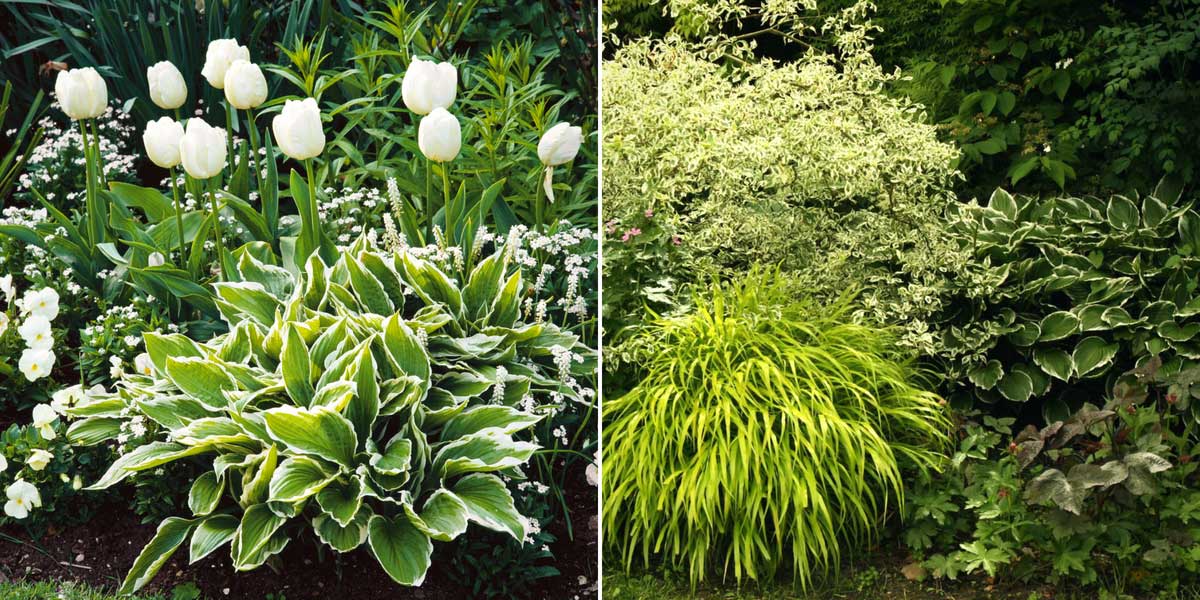
You can combine hostas with variegated foliage and white flowers. Hosta ‘Silver Crown’, Tulip ‘Hibernia’ and ‘Matrix White’ pansies (Photo Clive Nichols – MAP) / Hosta, Cornus alternifolia ‘Argentea’ and Hakonechloa macra ‘All Gold’ (photo Virginie Douce)
With its ample and generous foliage, hostas have quite an exotic side: they can help you create a garden that feels like a getaway, alongside other large and well-developed foliage. For example, install gunneras, ferns (ideally, tree species!), Rodgersia, banana plants (Musa basjoo) or Datisca cannabina… Bring a great diversity in leaf shapes and shades. Add some surprising flowers, such as those of Arisaema or Hedychium. You will achieve a lush, almost tropical effect!
Hostas also find their place in a city garden. You can install them in pots on a terrace or patio for a graphic and modern atmosphere. Plant nearby some horsetails, bamboos, Japanese maples, and a few flowering plants, such as Alliums, nemorosa sages, and agapanthus. Scatter some clumps of grasses: Carex, Pennisetum, Stipa pennata…
Finally, you can create an Asian-style bed. For example, design a zen garden by combining hostas with bamboos, Arisaema, Carex oshimensis, and some shrubs like Japanese maples (Acer palmatum) and Cornus kousa. Place ferns like Athyrium niponicum or Coniogramme emeiensis.
For (even) more inspiration, read: “Hostas: 7 ideas for successful combinations
Did you know?
- An edible plant!
Hostas are grown to be consumed as vegetables in Asia, particularly in Japan, where they are called Urui. The flower buds, young shoots, and tender leaves, harvested in spring, can be used in cooking. The young shoots are usually cooked and blanched, the leaves can be prepared like spinach, while the flowers are typically eaten raw, to decorate salads. The most commonly consumed species is Hosta montana.
- A collection of hostas
The Arboretum des Prés des Culands in Meung-sur-Loire (in Loiret) houses the National Collection of Hostas, certified by the Conservatoire des Collections Végétales Spécialisées (CCVS). It features no fewer than 120 varieties!
Useful resources
- Discover our (very) wide range of hostas!
- An article by Michael on our blog – How to Fail with Hostas in 4 Lessons?
- Find our article: 9 Hostas Resistant to Slugs
- A site with plenty of information on hostas and their cultivation (in French)
- The site of the American Hosta Society (in English)
- Advice sheet: 4 Giant Hostas: the Most Spectacular Varieties!
- Advice sheet: 4 Dwarf Hostas
- Advice sheet: The Most Beautiful Variegated Hostas, Blue Hostas: the Most Beautiful Varieties; The Best Green-Leaved Hostas to Dress Up Your Garden; The Best Yellow or Golden-Leaved Hostas to Brighten Up the Garden
- Advice sheet: Fragrant Hostas
- Also discover our advice sheet on Slow-Establishing Plants
- Michael’s favourite: the Striped Hosta ‘Siberian Tiger’
- Discover Hostas: the Sure Values;
- Did you know that young hosta shoots are edible?: more details in How to Cook and Consume Hosta Shoots?
Frequently asked questions
-
The leaves of my hosta are riddled with holes... What should I do?
Stop searching, the culprits are slugs! They love the large, tender, and soft leaves of hostas. You can use slug pellets such as Ferramol, or place ashes or sawdust around your plants to create a barrier. Another solution is to grow hostas in pots, which you can place out of reach of slugs (find a support that is difficult for them to climb!). Finally, you can favour varieties with thick, tough foliage that are more resistant, such as ‘Big Daddy’, ‘June’, ‘Halcyon’, ‘Blue Mouse Ears’, or ‘Sum and Substance’...
-
The foliage of my hosta is turning brown or dried out.
If you have planted it in full sun, the leaves are likely scorched. Hosta does not like excessively hot conditions. For example, avoid placing it in front of a white wall that would reflect heat and could potentially burn it. However, different varieties do not react the same way. Those with blue leaves and variegated foliage are the most sensitive. It is also possible that the soil is too dry. Hosta tolerates the sun much better when the substrate remains cool. Finally, remember that hosta is a deciduous plant... It is normal for its foliage to eventually dry out in autumn when temperatures become cold.
-
My hosta isn't flowering... What should I do?
It is likely planted in too dense a shade! Hostas need a bit of sun and light to be able to flower! Consider moving it or lightly pruning the trees that are shading it. Similarly, they can take several years to settle in properly and start flowering... If you planted it recently, you will need to wait a bit before enjoying it!
-
The colour of my hosta is not what it should be... Why?
The colour of some hostas varies depending on the light conditions. It will not be the same if you place the plant in sunlight or under dense shade. The varieties with blue foliage lose the waxy coating responsible for their colour when exposed to sunlight, turning green instead. Similarly, if the plant is from a sowing, it may not be identical to the original variety in terms of leaf colour and variegation. Finally, if you have ordered from the site and the variety received seems to be incorrect, do not hesitate to contact us!
- Subscribe!
- Contents
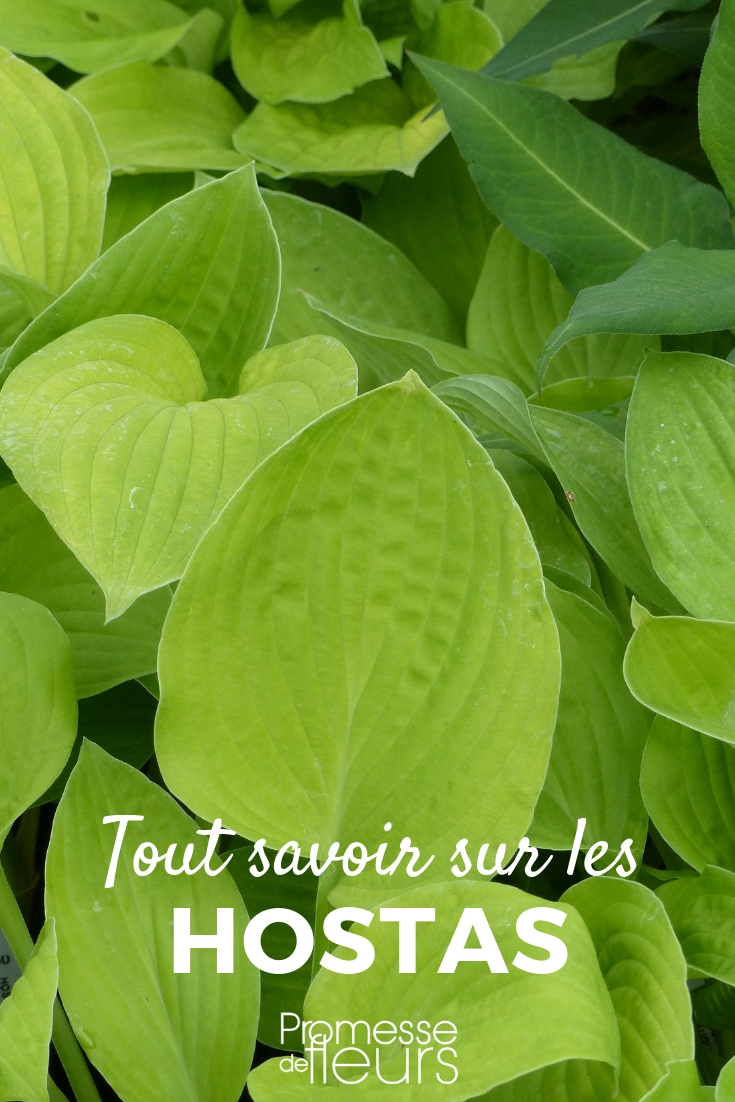































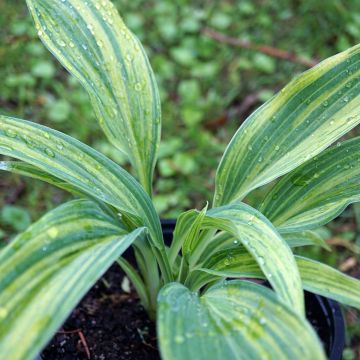
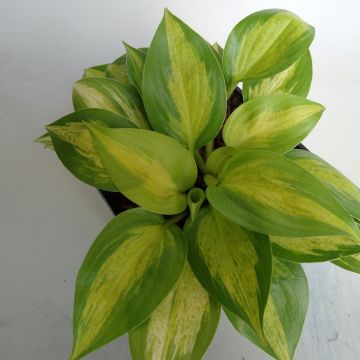
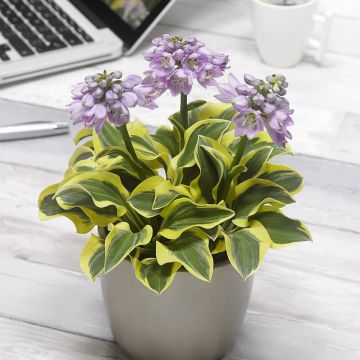
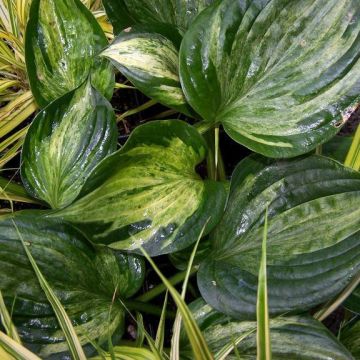

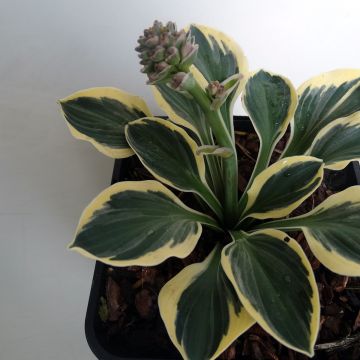


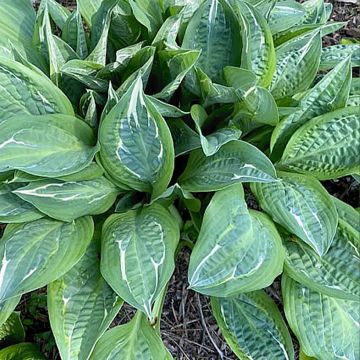
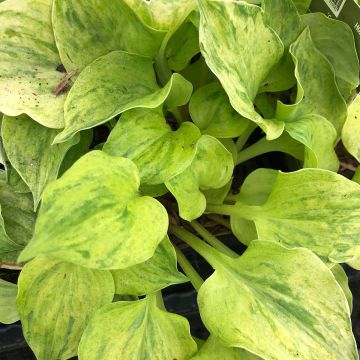
Comments